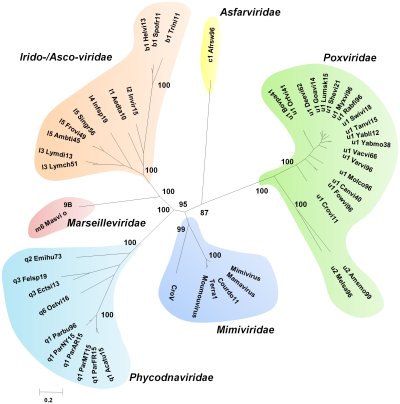Worth a Thousand Words
The image above is from the paper, The Giant Cafeteria roenbergensis Virus That Infects a Widespread Marine Phagocytic Protist Is a New Member of the Fourth Domain of Life and is this week’s picture of the week. The image, which is Figure 1 of the manuscript, illustrates the phylogenetic tree of nucleo-cytoplasmic large DNA viruses (NCLDVs).
From the abstract:
Background
A recent work has provided strong arguments in favor of a fourth domain of Life composed of nucleo-cytoplasmic large DNA viruses (NCLDVs). This hypothesis was supported by phylogenetic and phyletic analyses based on a common set of proteins conserved in Eukarya, Archaea, Bacteria, and viruses, and implicated in the functions of information storage and processing. Recently, the genome of a new NCLDV, Cafeteria roenbergensis virus (CroV), was released. The present work aimed to determine if CroV supports the Fourth Domain of Life hypothesis.
Methods
A consensus phylogenetic tree of NCLDVs including CroV was generated from a concatenated alignment of four universal proteins of NCLDVs. Some features of the gene complement of CroV and its distribution along the genome were further analyzed. Phylogenetic and phyletic analyses were performed using the previously identified common set of informational genes present in Eukarya, Archaea, Bacteria, and NCLDVs, including CroV.
Findings
Phylogenetic reconstructions indicated that CroV is clearly related to the Mimiviridae family. The comparison between the gene repertoires of CroV and Mimivirus showed similarities regarding the gene contents and genome organization. In addition, the phyletic clustering based on the comparison of informational gene repertoire between Eukarya, Archaea, Bacteria, and NCLDVs unambiguously classified CroV with other NCLDVs and clearly included it in a fourth domain of Life. Taken together, these data suggest that Mimiviridae, including CroV, may have inherited a common gene content probably acquired from a common Mimiviridae ancestor.
Conclusions
This further analysis of the gene repertoire of CroV consolidated the fourth domain of Life hypothesis and contributed to outline a functional pan-genome for giant viruses infecting phagocytic protistan grazers.
This paper is freely available for you to read, rate, and share. If you’re interested in learning more about the Fourth Domain of Life, you can read – Stalking the Fourth Domain in Metagenomic Data: Searching for, Discovering, and Interpreting Novel, Deep Branches in Marker Gene Phylogenetic Trees.

